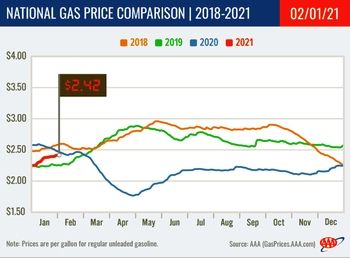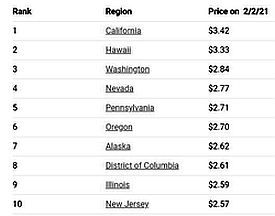
Publisher:
Bonnie King
CONTACT:
Newsroom@Salem-news.com
Advertising:
Adsales@Salem-news.com

~Truth~
~Justice~
~Peace~
TJP
Feb-02-2021 23:27

 TweetFollow @OregonNews
TweetFollow @OregonNews
Rising Crude Prices put Brakes on Savings at the Pumps
Salem-News.comOregon is one of 46 states with higher prices now than a week ago.
 |
(PORTLAND, Ore.) - For the last 337 days, the national gas price average has been cheaper year-over-year—as much as $1.12 a gallon less. However, AAA predicts that trend will end as early as this week.
Currently, the national average is just a nickel less than a year ago. That gap is much larger in Oregon as the current average is 27 cents less than one year ago.
“For nearly a year, drivers have been saving 53 cents a gallon, on average, when filling up their gas tanks.
"That extra pocket change is quickly going away due to rising crude oil prices that have made for more expensive pump prices,” says Marie Dodds, public affairs director for AAA Oregon/Idaho.
Gas prices continued to climb this past week despite a drop in gasoline demand and refinery utilization. According to the latest U.S. Energy Information Administration (EIA) measurements, demand declined from 8.11 million b/d to 7.83 million b/d and total refinery utilization decreased from 82.5 percent to 81.7 percent over last week. These decreases led to an increase in gasoline supply of 2.4 million bbl.
Typically, these factors (decrease in demand, increase in supply) drive a drop at the pump, but sustained crude oil prices are pushing the increase. For three weeks, crude continued to price between $52 and $53/bbl, and then increased above $54/bbl this week. These are price points not seen since mid-February 2020.
Gas prices are expected to continue to increase as crude oil prices remain at these price points, even as gasoline demand remains below 2020 levels due to the coronavirus pandemic.
Visit AAA.com/covidmap for an interactive map with the latest travel restrictions and policies for North America. Find AAA’s latest COVID-19 information for travelers here.
Oregon is one of 46 states with higher prices now than a week ago. Indiana (+9 cents) has the largest weekly increase. Delaware (-1 cent) has the largest weekly decrease.
For the 34th week in a row, California ($3.42) and Hawaii ($3.33) are the only two states in the nation with an average at or above $3 a gallon.
The cheapest gas in the nation can be found in Mississippi ($2.11) and Missouri ($2.13). For the fourth week in a row, no state has an average below $2 a gallon.
All 50 states and the District of Columbia have higher prices now than a month ago. The national average is 13 cents more and the Oregon average is 10 cents more than a month ago. This is the 45th-largest month-over-month increase in the nation.
West Virginia (+24 cents) has the largest monthly increase in the country. Hawaii (+4 cents) has the smallest.
Oregon is one of 39 states and the District of Columbia with lower prices now than a year ago. The national average is five cents less and the Oregon average is 27 cents less than a year ago. This is the sixth-largest yearly drop in the nation.
Arizona (-38 cents) has the largest year-over-year decline. Delaware (+23 cents) has the biggest yearly increase.
West Coast
 The West Coast region continues to have the most expensive pump prices in the nation with every state in the region except Arizona in the top 10.
The West Coast region continues to have the most expensive pump prices in the nation with every state in the region except Arizona in the top 10.
California is the most expensive state for the fourth week in a row, with Hawaii, Washington, and Nevada rounding out the top four. Oregon is sixth for the third week in a row. Alaska is seventh and Arizona is 16th.
As mentioned above, California and Hawaii are the only two states in the nation with an average at or above $3 a gallon.
States in the West Coast region are seeing relatively small changes in gas prices in the last week. California (+4 cents) has the largest weekly increase in the region.
Alaska (+1 cent) has the smallest week-over-week increase. Hawaii (-1 cent) is the only state in the region with a weekly decrease.
According to EIA’s latest weekly report, total gas stocks in the region increased from 32.67 million bbl to 33.60 million bbl last week. This may temper pump price increases in the region this week.
Oil market dynamics
This week crude oil prices have jumped to a one-year high due to declining global supplies and rising winter fuel demand as a major snow storm pummels the East Coast. Crude prices are poised to continue rising this week.
Crude oil price gains were limited last week by ongoing market concern that crude demand may take more time than expected to recover in 2021 due to new coronavirus infections and associated travel restrictions.
However, EIA’s new weekly report prompted crude price increases earlier in the week after it showed total domestic crude inventories declined by 9.9 million bbl to 476.7 million bbl, which is the largest weekly decline since late July 2020. For this week, crude prices may rise optimism due to declining global supplies.
At the close of Friday’s formal trading session, WTI decreased by 14 cents to settle at $52.20. At the close of Monday’s formal trading session, WTI rose $1.35 to settle at $53.55.
Today crude is trading around $55, compared to $53 a week ago. Crude prices are up about 16 percent in the last month and are about $2 more than a year ago.
Drivers can find current gas prices along their route with the free AAA Mobile app for iPhone, iPad and Android. The app can also be used to map a route, find discounts, book a hotel and access AAA roadside assistance. Learn more at AAA.com/mobile.
Diesel
For the week, the national average adds a penny to $2.65 a gallon. Oregon’s average holds steady at $2.75. A year ago the national average for diesel was $2.95 and the Oregon average was $3.21.
Source: AAA/Oregon
Articles for February 1, 2021 | Articles for February 2, 2021 | Articles for February 3, 2021

Salem-News.com:
googlec507860f6901db00.html

Quick Links
DINING
Willamette UniversityGoudy Commons Cafe
Dine on the Queen
Willamette Queen Sternwheeler
MUST SEE SALEM
Oregon Capitol ToursCapitol History Gateway
Willamette River Ride
Willamette Queen Sternwheeler
Historic Home Tours:
Deepwood Museum
The Bush House
Gaiety Hollow Garden
AUCTIONS - APPRAISALS
Auction Masters & AppraisalsCONSTRUCTION SERVICES
Roofing and ContractingSheridan, Ore.
ONLINE SHOPPING
Special Occasion DressesAdvertise with Salem-News
Contact:AdSales@Salem-News.com

Terms of Service | Privacy Policy
All comments and messages are approved by people and self promotional links or unacceptable comments are denied.
randall Krysta February 16, 2021 5:10 am (Pacific time)
Newflash...Bidens ridiculous undoing of good policy leads to rising crude prices affecting price at the pump. Expect dramatic increases as extreme green policies take place. Taxes will also increase in order to line the pockets of NGOs and big government.
[Return to Top]©2026 Salem-News.com. All opinions expressed in this article are those of the author and do not necessarily reflect those of Salem-News.com.